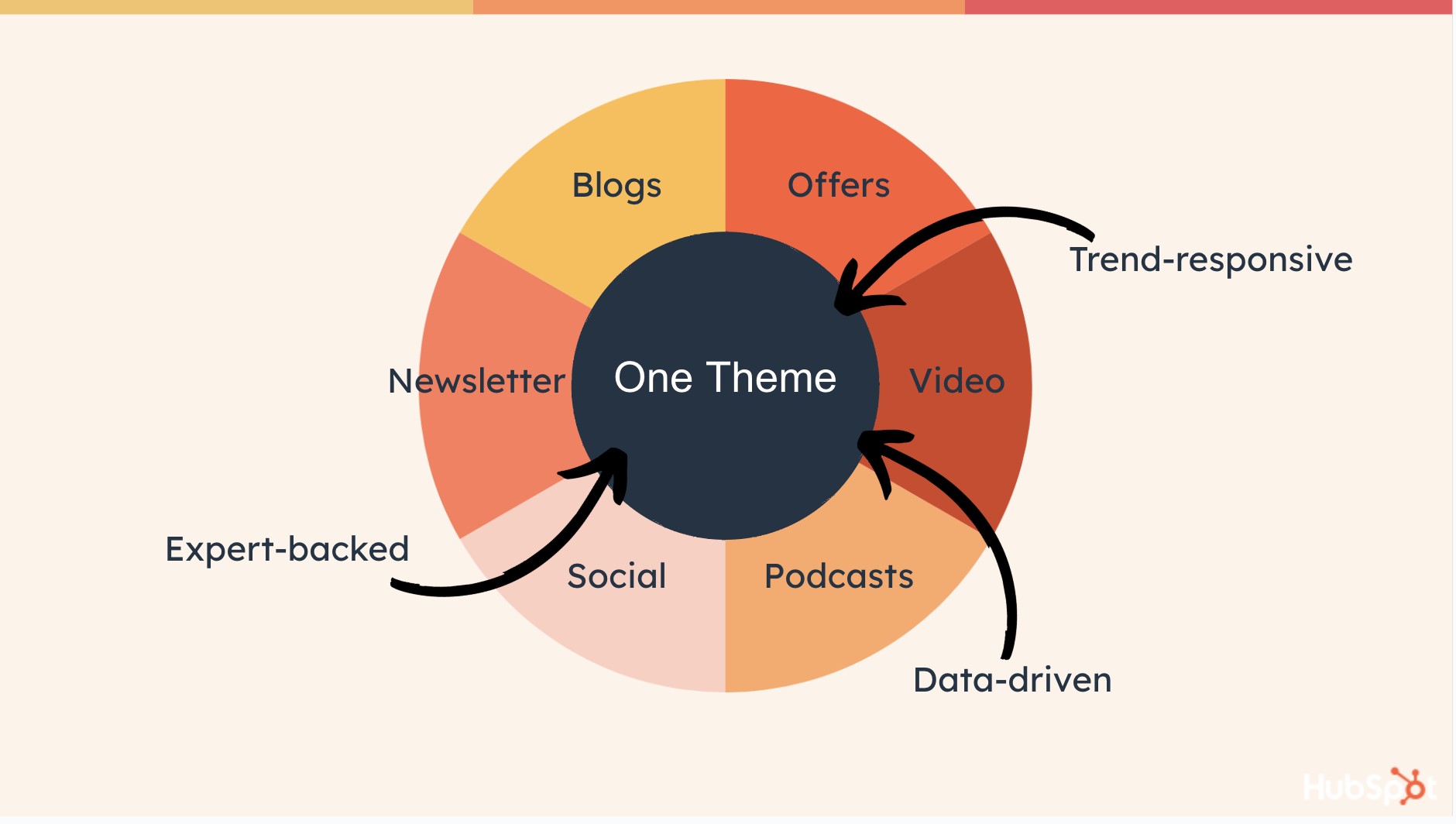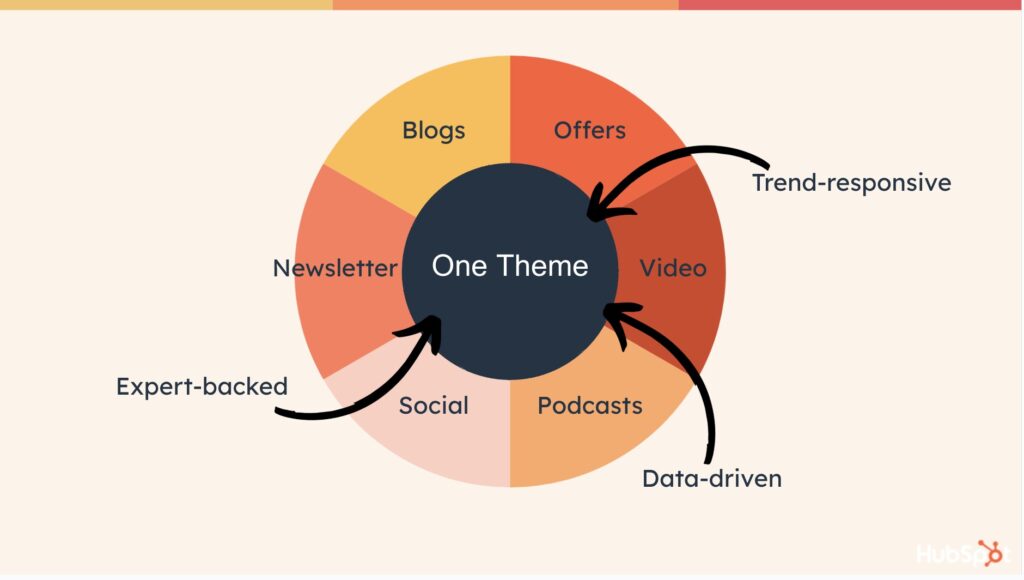It wasn't too long ago that we weren’t collaborating much across Marketing.
If I published a blog post on “SEO strategy”, it became a happy coincidence if the YouTube team had covered anything similar that I could use in my post.
Teams just weren't creating content cohesively across different verticals. Let’s be honest: We'd grown too large.
On the Blog team, this also meant we had limited non-organic channels to use to get our posts in front of the right audiences.
Today, I'm going to pull back the curtain (sorry, I just saw Wicked) on how HubSpot's Blog team reimagined our approach to content — transforming what used to be a siloed blog strategy into a dynamic, multi-channel storytelling machine.
(Psst: Curious what else is happening in the world of blogging? Check out our brand-new 2025 State of Blogging report with data from 500+ marketers — the first time we've ever run such a comprehensive audit on what's happening across the blogging landscape.)
Why We Launched Our Media Narratives Program
When we first started our Original Research program in 2017, something became immediately clear: our blog readers are absolutely obsessed with data.
Like, Taylor-Swift-friendship-bracelets-level obsessed.
In our first full year, we drove over 1.4 million views through original research. Turns out, people love data — regardless of platform.
The challenge? Quality research is pricey and time-consuming. We needed a more strategic approach to not just create research, but to distribute it effectively across multiple channels to make sure we were getting the biggest bang for our research-bucks.
For instance, you shouldn't have to be a blog reader to access our State of Marketing data — although, selfishly, I’d love it if you were.
But if instead you're an avid YouTuber, newsletter subscriber, or IG follower, you should still be able to access the top marketing trends on those platforms, too.
Enter: Media Narratives.
In June 2022, I piloted our first Media Narrative — a quarterly approach that would transform how we think about research, content, and cross-team collaboration.
What started as an experimental program quickly became a powerful distribution engine for our original research, blog, and brand.
What is a Media Narrative?
Media Narratives is, at its core, a collection of multimedia content centered around one data-backed theme.
Think: A YouTube video, podcast episode, blog post, and a TikTok vid, all discussing the same trending topic and driving traffic towards one final offer.
Each Media Narrative is fueled by the Blog's original research and expert thought leadership, and always has one corresponding research-backed report.
Let's break it down in bullet-point format. A Media Narrative consists of:
- One targeted, research-backed offer (think: State of Marketing, State of Sales, State of AI)
- 15+ in-depth blog posts discussing the subtopics of that overarching report (i.e. “top marketing challenges”, “top marketing channels”, “marketing KPIs to focus on”)
- Expert interviews
- Videos
- Podcast mentions
- Social content
… With original research as the foundation for each individual channel's content.
And, to-date, Media Narratives have driven over 6M+ views to the Blog.

How Media Narratives Help Us Solve for Channel Volatility
As organic search became increasingly unpredictable in 2024, we developed a brand-new, robust strategy that doesn't just rely on traditional SEO tactics.
But we had another secret weapon, too: Media Narratives.
Media Narratives have helped cushion the blow of search volatility over the past year for two reasons:
- Media Narratives leverage multiple distribution channels — like YouTube, social media, and podcasts — which help us create content for platforms that are less impacted by the organic tides.
- Media Narratives content helps us compete against AI, since Media Narrative content is too difficult to replicate using AI. You know… Being focused on human perspectives, and all.
In other words, Media Narratives guarantee we don't have all of our eggs in one basket.
We distribute content on all the channels our audience might prefer, so they can decide how, where, and why they want to consume our content.
Well … Hopefully they're not asking why.
Plus, we publish content for Media Narratives like “Marketing Budgets: How Much Should Your Team Spend in 2024?” and “The Top 5 Marketing Challenges Expected Globally in 2025, And How to Overcome Them” — two topics I'd rather not ask a robot about.
What This Means for Marketers [3 Lessons for 2025]
1. Don't just rely on search.
Okay, okay — I know this is an obvious one.
But it's also surprisingly difficult. Our Blog strategy still relies primarily on organic traffic.
Because, let's face it … Social media users aren’t too eager to click on a blog link that takes them off of TikTok. I get it.
But we've found it increasingly vital to test content on new channels.
Non-organic content deserves its time to shine. You'll probably never Google keyword terms like “$400K fighter jets” and “Anti-marketing Liquid Death”, right?
And yet — and I hope this isn't too presumptuous — I think you’d like to read, “Martha Stewart, $400K Fighter Jets, and Comedy Writers: How Liquid Death Wins at Anti-Marketing, According to Liquid Death's VP”.

So give it a shot — share your blog posts via newsletters, social posts, YouTube descriptions, and more. And try out some newer UGC distribution channels, like Substack, Reddit, and Discord.
You want to play by the rules of each platform (cough, cough: Don't spam your followers) but you should still get creative when it comes to how you get your content out there.
Still curious what other marketers' are up to? Give our 2025 State of Blogging report (with data from 500+ marketers) a read.
2. Invest in original research.
We've all seen it first-hand: In the age of AI, way too many marketers are getting comfortable publishing generic "5 Marketing Trends" posts straight from the fingertips of good ole’ GPT.
So… What's the Batman to ChatGPT’s Robin? Real, human perspectives.
Original data coupled with expert opinions is your competitive advantage in a world of AI-generated content.
It's expensive, but it might be a worthwhile investment if it allows you to outrank your competitors while making your content more valuable.
If you do decide to invest in original research, I'd suggest to start small with a research report that correlates strongly to your highest-intent topics. If you sell video marketing software, a video marketing report is your sweet spot.
3. Embrace cross-team collaboration.
Our most successful Narratives break down silos.
When your podcast, social, newsletter, and blog teams work together, you create something greater than the sum of its parts.
It isn't easy. It required a project-management mindset I wasn’t used to, and ultimately, I needed to take the time to learn how each team operates (and their preferred communication styles) before I got it right.
What I learned is this: When working with other teams, it's important to create collaboration opportunities in multiple formats.
For me, this meant organizing a quarterly Zoom meeting that stakeholders could join, or an async spreadsheet they could drop notes into, or the option for a 1:1 meeting with me to discuss how we might work together.
This might look different for you, but it's a good idea to collect feedback across teams to ensure you’re creating a process that works for everyone.
Playing It Safe Means Being Left Behind
If there's one thing I’ve learned from owning Media Narratives, it's this: Content success isn’t about playing it safe.
Instead, it's about being bold, data-driven, and adaptable.
Our Media Narratives program is proof that sometimes, the bigger bets can pay off. It helped us solve for some major internal issues (siloed content teams), while creating more interesting content for our audiences.
And being a strong defense against AI was an added bonus.
My point? Use 2025 to test out some new pilot programs. Heck – give something like your own Media Narratives a shot. You never know how it'll do.

